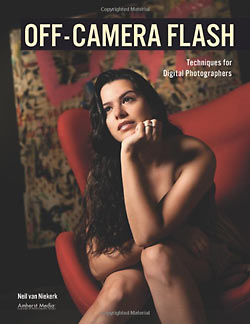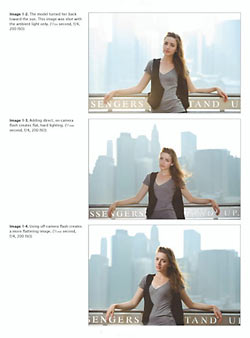 Neil van Niekerk is one of my favorite writers on flash photography. When I reviewed his earlier book, On-Camera Flash, I got so excited that I praised him as “…that rarest of things, a great teacher.”
Neil van Niekerk is one of my favorite writers on flash photography. When I reviewed his earlier book, On-Camera Flash, I got so excited that I praised him as “…that rarest of things, a great teacher.”
Thankfully he hasn’t made a liar out of me with his second book. Off-Camera Flash: Techniques for Digital Photographers fully lives up to that earlier praise, and more.
In a richly informative yet admirably concise 125 pages, Off-Camera Flash provides a wide-ranging look at its subject without becoming lost in the technical mire—and believe me, with this subject, it can be easy to get bogged down in the details.
Modern hot-shoe flash units have become so complex—in many ways more complex than our cameras—that some less-technically-minded photographers have simply thrown up their hands in despair (this has been known to lead to a newfound “artistic” viewpoint that adamantly defends natural light as the only true light).
But have no fear. Neil van Niekerk rides to the rescue with this well-organized and lavishly illustrated guide. Sure, it requires some technical knowledge of f-stops and shutter speeds, and there is hardly a page without at least one acronym like TTL, ISO, or occasionally even a CTS, but he truly makes the subject about as painless as it can be.
 Best of all, he illustrates his principles abundantly with photos—so abundantly that a flip through the pages reveals more photos than text. I particularly like his frequent use of an ambient-light photo next to the equivalent flash photo, so your eye gets trained in making the leap from, “If this is how my subject looks in a natural light test shot, then I can add flash to get this result…”
Best of all, he illustrates his principles abundantly with photos—so abundantly that a flip through the pages reveals more photos than text. I particularly like his frequent use of an ambient-light photo next to the equivalent flash photo, so your eye gets trained in making the leap from, “If this is how my subject looks in a natural light test shot, then I can add flash to get this result…”
The case study photos reflect the basic workload of a commercial photographer: weddings, models, fashion, and portraits, plus a smattering of travel and street shots to show that you can still do OCF when you don’t have time for a careful setup or the help of an assistant.
Many of you will be interested to know that this book makes an ideal companion to my own off-camera-flash portrait photography course, because van Niekerk and I tackle the subject from different angles. Where my course gives you a basic introduction to the subject in easy-to-digest video format—with heavy emphasis on beginner’s equipment and the technical details of flash settings—van Niekerk’s book takes a more advanced working-photographer’s view of the subject, focusing less on the equipment and more on the art of creating the environments, and the lighting, that yield particular artistic or commercial results. It’s the perfect Advanced Course to follow up my beginner’s video series.
Best of all, despite the professional-looking results of his work, van Niekerk’s approach does not require a lot of expensive gear. Most of the photos in the book were taken with a single Speedlite flash and one inexpensive modifier, because, as the author elegantly puts it, “In my opinion, that intersection between ‘best light’ and ‘simplicity’ is around the point where you use an off-camera flash in a softbox.”
That focus on simplicity informs the entire book.
Highly recommended.
As always, if you shop from my Amazon links, you help support this site (and you add a few pennies to my beer fund, providing essential fuel for producing more free tutorials).



Hey Phil,
It’s me Lenwood I’ve purchased Neil’s
Book and gone through it twice it’s full of
very good information, and worth any photographers
investment. For someone that wishes to get the basics down of
off camera flash this is the book to obtain.
one of my recommend top author
love his simplicity & creative idea
-www.benlawstudio.com
I happen to have this book checked out from my library right now. While there are a few places where I wish there was a bit more detail, especially regarding the specific placement of the light(s), overall I agree that it is a great resource.
Just added this to my Amazon Wish List. It sounds like it is a must read. What other Books or periodicals would recommend for for advanced amateurs? I am currently working my way through your old blog entries.
Bill